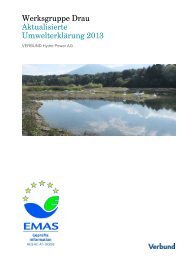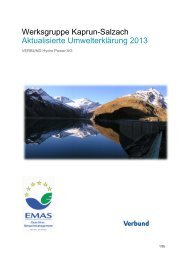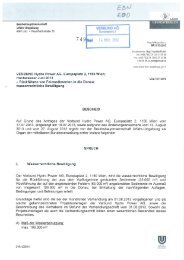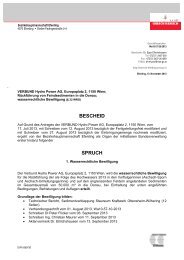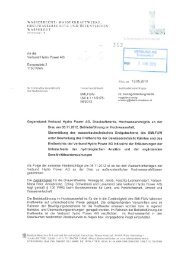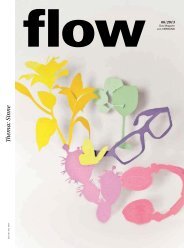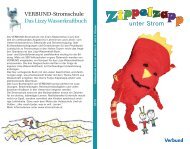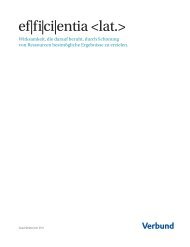Download PDF - Verbund
Download PDF - Verbund
Download PDF - Verbund
You also want an ePaper? Increase the reach of your titles
YUMPU automatically turns print PDFs into web optimized ePapers that Google loves.
Due to lively construction by migrant beavers, the fish migration in the bypass channel of the Freudenau<br />
power plant has been repeatedly and severely disrupted. To ensure that the fish passes are functional, in<br />
2008 certain types of beavers were removed manually as a compensatory measure. A beaver dam near<br />
the bypass channel that did not disturb the fish migration was left in place. Fish passes can be accessed<br />
in full during prime spawning season, as these measures do not disturb the beavers and have not driven<br />
them from the area.<br />
BIODIVERSITY FOR THERMAL GENERATION AND<br />
TRANSMISSION GRIDS<br />
Projects are also being implemented to maintain biodiversity in thermal generation and transmission<br />
grids. The primary focus is on avoiding negative effects on certain species of animals and on creating and<br />
managing ecologically sound habitats.<br />
The European bee eater is a migrant bird. Its striking blue-yellow-red feathers make it one of Carinthia’s<br />
most impressive migratory birds. It is on the “red list”, considered highly endangered under Carinthia’s<br />
natural conservation laws. It needs diverse cultural landscapes with a high level of lush greenlands and a<br />
sufficient number of bush groups, single trees, wires, etc. to use as a perch. In the late 1990s, the bee eater<br />
had optimal breeding conditions in the steep slopes of the St. Andrä power plant’s ash heap. A nearby<br />
pond offered enough food and the European bee eater reached its highest population density at about<br />
40 adult and 60 fledgling birds.<br />
Because the ashes were continually removed and used as a cement substitute, a solution had to be found<br />
to maintain the nesting area, which had become a limited resource. Because the European bee eaters<br />
carve new breeding holes into the slopes every year, one level of ashes is removed each breeding season.<br />
In early spring, the steep walls are straightened to create the optimal breeding conditions.<br />
In 2009, a species protection project by Arge NATURSCHUTZ, sponsored by <strong>Verbund</strong>, was launched<br />
for the European bee eaters and the kingfisher. This makes it possible to collect precise data on the<br />
population count and lifestyle of these rare species of birds while helping to protect this unique bird<br />
community.<br />
Maintaining power line routes poses ecological, economic and social demands. For this reason, <strong>Verbund</strong><br />
laid down key guidelines for sustainable route management back in 1997. It includes measures to<br />
maintain the routes, to improve the habitat for flora and fauna, to expand and care for the biotopes and<br />
special promotion of sociocultural projects in the surrounding areas of the grid systems. The purpose<br />
of ecological route maintenance is to minimise or completely avoid interfering with the landscape and<br />
with the balance of nature. Additionally it aims to use the potential for nature and species protection.<br />
The research project “sustainable route management” has defined guidelines for route maintenance for<br />
the entire transmission grid – some 3,500 kilometres in length that includes around 6,700 kilometres of<br />
lines. The development options defined provide a basis for negotiations with regard to maintaining the<br />
line routes and for decisions regarding measures to be taken in cooperation with the landowners. Firstly,<br />
the guidelines provide a general depiction of natural protection and forestry priorities (habitats, species,<br />
biotope mixes, etc.) along the routes. Secondly, they outline ecologically precious biotopes crossed by<br />
the route and that need special care or attention as part of route maintenance. Thirdly, they estimate the<br />
potential for route maintenance for select nature conservation goals (i.e. designing the forest borders,<br />
ecological mast base design for the open landscape).<br />
In Austria, the great bustard is currently the most heavily threatened by collisions with conductors for<br />
medium and high voltage lines. Following a dramatic decline in both the Austrian and the general west<br />
Pannonian great bustard population, extensive measures in recent years have improved the habitat.<br />
From 2005 to 2007, a LIFE Nature project was implemented for the protection of the great bustard.<br />
2010 – THE YEAR OF BIODIVERSITY | SUSTAINABILITY REPORT 2009 | 27<br />
ANNUAL BEAVER MANAGEMENT<br />
PROGRAMME AT FREUDENAU<br />
POWER PLANT<br />
EUROPEAN BEE EATERS<br />
AT ST. ANDRÄ<br />
SUSTAINABLE ROUTE<br />
MANAGEMENT<br />
CROSS-BORDER PROTECTION<br />
OF THE GREAT BUSTARD IN<br />
AUSTRIA



